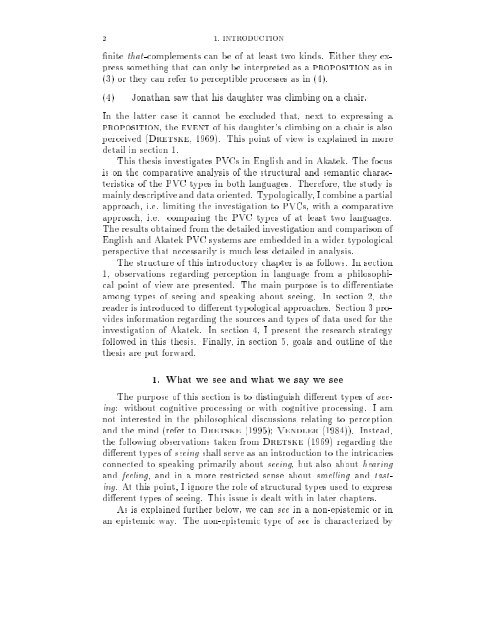Perception verb complements in Akatek, a Mayan language
Perception verb complements in Akatek, a Mayan language
Perception verb complements in Akatek, a Mayan language
You also want an ePaper? Increase the reach of your titles
YUMPU automatically turns print PDFs into web optimized ePapers that Google loves.
2 1. INTRODUCTION<br />
nite that-<strong>complements</strong> can be of at least two k<strong>in</strong>ds. Either they express<br />
someth<strong>in</strong>g that can only be <strong>in</strong>terpreted as a proposition as <strong>in</strong><br />
(3) or they can refer to perceptible processes as <strong>in</strong> (4).<br />
(4) Jonathan saw that his daughter was climb<strong>in</strong>g on a chair.<br />
In the latter case it cannot be excluded that, next to express<strong>in</strong>g a<br />
proposition, the event of his daughter's climb<strong>in</strong>g on a chair is also<br />
perceived (Dretske, 1969). This po<strong>in</strong>t of view is expla<strong>in</strong>ed <strong>in</strong> more<br />
detail <strong>in</strong> section 1.<br />
This thesis <strong>in</strong>vestigates PVCs <strong>in</strong> English and <strong>in</strong> <strong>Akatek</strong>. The focus<br />
is on the comparative analysis of the structural and semantic characteristics<br />
of the PVC types <strong>in</strong> both <strong>language</strong>s. Therefore, the study is<br />
ma<strong>in</strong>ly descriptive and data oriented. Typologically, I comb<strong>in</strong>e a partial<br />
approach, i.e. limit<strong>in</strong>g the <strong>in</strong>vestigation to PVCs, with a comparative<br />
approach, i.e. compar<strong>in</strong>g the PVC types of at least two <strong>language</strong>s.<br />
The results obta<strong>in</strong>ed from the detailed <strong>in</strong>vestigation and comparison of<br />
English and <strong>Akatek</strong> PVC systems are embedded <strong>in</strong> a wider typological<br />
perspective that necessarily is much less detailed <strong>in</strong> analysis.<br />
The structure of this <strong>in</strong>troductory chapter is as follows. In section<br />
1, observations regard<strong>in</strong>g perception <strong>in</strong> <strong>language</strong> from a philosophical<br />
po<strong>in</strong>t of view are presented. The ma<strong>in</strong> purpose is to di erentiate<br />
among types of see<strong>in</strong>g and speak<strong>in</strong>g about see<strong>in</strong>g. In section 2, the<br />
reader is <strong>in</strong>troduced to di erent typological approaches. Section 3 provides<br />
<strong>in</strong>formation regard<strong>in</strong>g the sources and types of data used for the<br />
<strong>in</strong>vestigation of <strong>Akatek</strong>. In section 4, I present the research strategy<br />
followed <strong>in</strong> this thesis. F<strong>in</strong>ally, <strong>in</strong> section 5, goals and outl<strong>in</strong>e of the<br />
thesis are put forward.<br />
1. What we see and what we saywe see<br />
The purpose of this section is to dist<strong>in</strong>guish di erent types of see<strong>in</strong>g:<br />
without cognitive process<strong>in</strong>g or with cognitive process<strong>in</strong>g. I am<br />
not <strong>in</strong>terested <strong>in</strong> the philosophical discussions relat<strong>in</strong>g to perception<br />
and the m<strong>in</strong>d (refer to Dretske (1995); Vendler (1984)). Instead,<br />
the follow<strong>in</strong>g observations taken from Dretske (1969) regard<strong>in</strong>g the<br />
di erenttypes of see<strong>in</strong>g shall serveasan<strong>in</strong>troduction to the <strong>in</strong>tricacies<br />
connected to speak<strong>in</strong>g primarily about see<strong>in</strong>g, but also about hear<strong>in</strong>g<br />
and feel<strong>in</strong>g, and <strong>in</strong> a more restricted sense about smell<strong>in</strong>g and tast<strong>in</strong>g.<br />
At this po<strong>in</strong>t, I ignore the role of structural types used to express<br />
di erent types of see<strong>in</strong>g. This issue is dealt with <strong>in</strong> later chapters.<br />
As is expla<strong>in</strong>ed further below, we can see <strong>in</strong> a non-epistemic or <strong>in</strong><br />
an epistemic way. The non-epistemic type of see is characterized by

















